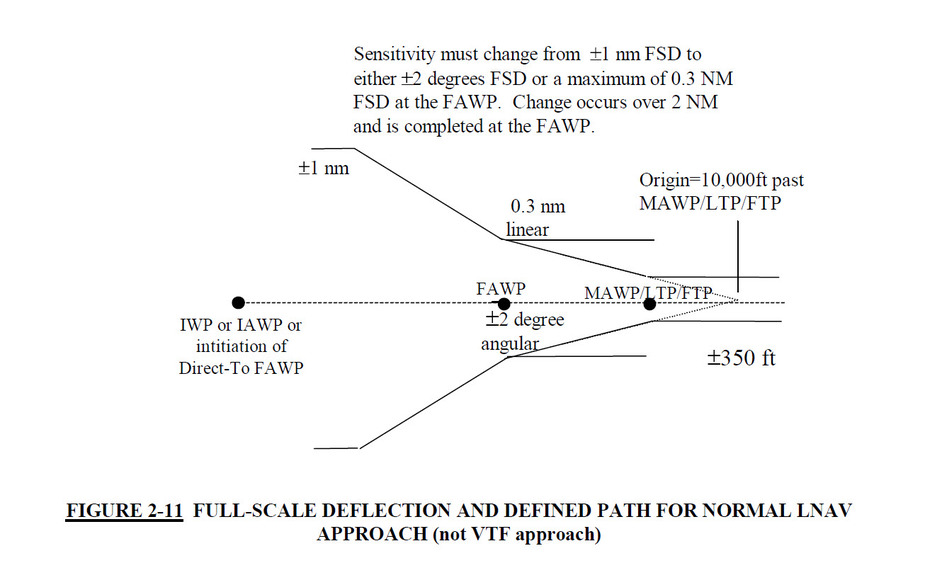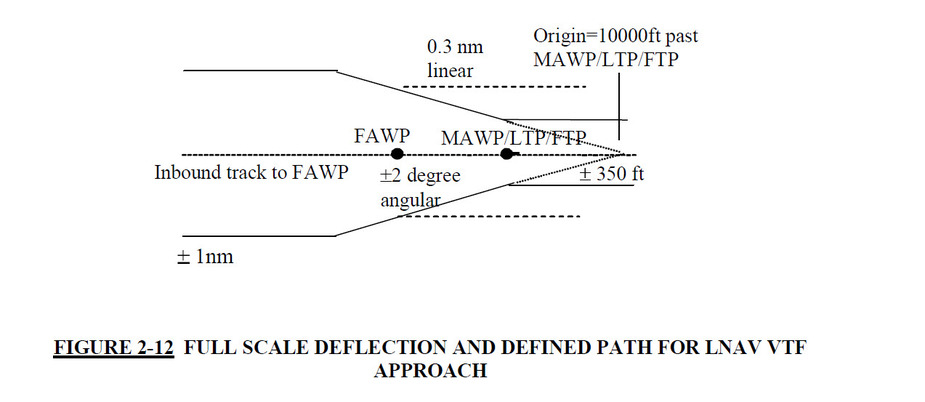RobertL18C wrote:
If the typical half deflection on a Localiser is the tan of 1.3 degrees, this translates to around 200 feet at minima on a 10,000 foot runway, while the 0.3nm on an LNAV is around 1,700 feet. The difference in sensitivity on an LPV which makes it a LOC equivalent is down to SBAS, and additional waypoints in the database. On an LNAV sensitivity ramps up to 0.3 nm in the run in to the FAF and stays there, whether the GPS navigator is WAAS or not.Jeppesen will remove the additional dataset for UK LPV approaches, so while the WAAS GPS navigator can navigate to higher accuracy, it will fly the LNAV with the CDI having the same sensitivity as a non WAAS GPS.
Robert,
It is optional with a WAAS GPS to use either fixed CDI FSD of +/- 0.3 NM or angular +/- 2 degrees. All the WAAS GPS navigators I am familiar with use angular CDI deviations on an LNAV procedure equal to +/- 2 degrees. It is true that the protected area is fixed at 2 times the RNP value of 0.3 NM, but the CDI deflection is angular. At the FAF, the CDI FSD is +/- 0.3 NM or +/- 2 degrees, whichever is less and then angular to the threshold. These are the diagrams from RTCA DO 229D which are the specification used for TSO C145/146.


Thank you @NCYankee I had understood, wrongly, it behaved like a corridor!
The TSO C129 versions do behave as you described, but with WAAS, it is optional and so far all the implementations I have flown, GNS, GTN, G1000 are angular. I do believe the database could specify the CDI for a specific approach to use the fixed values of +/- 0.3 NM for FSD as at one point Garmin had a bug in that their angular implementations was simply +/- 2 degrees and did not comply with a maximum FSD of 0.3 NM at the FAF. For LNAV or LNAV/VVNAV approaches that had a final approach segment of 7 NM or more, the +/- 2 degrees is more than 0.3 NM. To fix those, Garmin recoded the database to use the linear +/- 0.3 NM option, but this also removed the database support for LNAV/VNAV or LPV if it existed on the approach. Eventually this was fixed with a software update to the GNS series and the database entries were restored.
Well from what I have read up on RNP approaches over the years and the stuff discussed here, I was of the opinion that the UK’s loss of LPV’s was all paperwork with no real loss of signal accuracy etc.(excepting that the lpv apps may disappear from the database)
However, I’m now told that this is wrong and there is a degradation( GA aviation community,Facebook):
“The Channel Islands are certainly covered by the local French
Stations but you’re missing the point. The stations make observations then they interpolate to provide exact corrections in a local lattice. These calculations are then uplinked to he geostationary satellites and down linked by our receivers. They simply stopped uplinking the UK (ionospheric) corrections.”
Is this correct?
PeteD wrote:
They simply stopped uplinking the UK (ionospheric) corrections.”Is this correct?
That does not make technical sense. The ionospheric corrections are based on a grid point thru which the GPS satellite signal passes. So without all of the possible grid points, one can’t apply the ionospheric corrections for all satellites in view, which will degrade the corrections for the ionosphere for every user. Remember satellites are in view from about 5 degrees above the horizon and the grid points that the signal passes through change as the satellite moves through its orbit. The EGNOS real time status shows the availability of LPV200 service that goes from Europe mainland to parts of Iceland. It includes all of the UK and Ireland. This requires a VPL of 35 meters or better. There are no LPV sites in the UK shown on the map, so it is not a technical issue, but an agreement issue.
I saw that post on some fb group too. It is from a retired airline pilot, and doesn’t make sense to me either.
Did the UK ever have LPV200? All the LPV DHs I have seen are much higher than that.
UK ones are LPV250 (Jersey is the only LPV200 nearby)
NCYankee wrote:
The TSO C129 versions do behave as you described, but with WAAS, it is optional and so far all the implementations I have flown, GNS, GTN, G1000 are angular.
Which makes sense. If the navigator has to provide angular deflections for LP and LPV anyway, why bother with linear deflection for LNAV and LNAV/VNAV?
NCYankee, thanks for your reply and clarification.
I feel there is enough misunderstanding on forums etc without it being added to by a supposedly knowledgeable person, hence my disagreement with them.
I am not aware of any mechanism via which EGNOS coverage could be denied on the basis of political country boundaries.
The signal is radiated from an antenna, or perhaps an array of them like has become common with satellite phone systems (multiple antennae, each one covering a few hundred nm diameter circle with a “spot beam” – google on Thuraya) so cannot be supplied to say Alderney and NW France but denied to the SW UK.
So the only possible geographical denial mechanism would be implemented in the navigator, on the basis of a GPS location in combination with a “denial” flag, but the algorithm is complex and I have never heard of any such thing.
I think the stuff being posted on UK social media is just BS. As always with these issues, the matter there polarises wholly according to Remainer/Leaver politics, the Remainers are 10x to 100x more vocal on social media (well, they are angry…) and I have not seen a single credible account of what actually happened that resulted in the loss of the SOL authorisation to the UK.
Yes it is possible Brussels is paying for the two monitoring stations on UK soil. Unlikely, IMHO, but who knows?